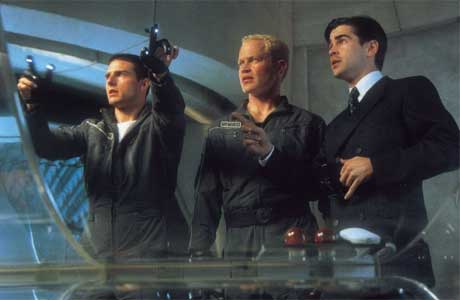
The way we control and interact with computers is set to change rapidly in the next five years, according to a leading computer scientist who will give this year's Royal Institution Christmas Lectures.
Prof Chris Bishop, who is chief research scientist at Microsoft Research in Cambridge and professor of computer science at the University of Edinburgh, will tell his audience that just like Tom Cruise's character in the film Minority Report, more of us will be manipulating and combining digital information by gesturing in thin air and flinging our hands over touchscreen devices.
He also predicts that 3D displays will replace the traditional flat screen for some applications.
Bishop told the Guardian that his lectures, which begin tomorrow in the newly refurbished Faraday Lecture Theatre at the Royal Institution in London, are about communicating the big ideas behind how computers and the internet work.
"You can get lost in the detail with computers," he said, "but if you strip away the detail there are a few very beautiful ideas. One of the things I want to do with the lectures is to bring those ideas alive."
This year's lectures are sold out, but they will be screened by Channel Five over Christmas.
The lectures – which have become as much a Christmas TV tradition as the Queen's speech and James Bond – were set up in 1825 by Michael Faraday to educate young people about science. Faraday himself presented 19 lecture series. Recent lecturers have included Sir David Attenborough, Richard Dawkins and Carl Sagan. They have been suspended only once, during the second world war.
As well as predicting what the future of computing holds, Bishop will wow his audience with some mind-boggling facts. For example, the fingernail-sized silicon chip at the heart of your desktop has 400m components, each a hundred times smaller than a bacterium. It can multiply two huge numbers together in a billionth of a second – the time it takes a high–speed rifle bullet to travel a tenth of the width of a human hair.
"People are very bad at that task – for example my arithmetic's terrible," confessed Bishop. "It would take me all day to multiply two big numbers together and I'd make a mistake anyway."
The silicon chips in laptops and desktops are just 1% of the roughly 10bn that are manufactured each year. The rest are often hidden in everyday objects. "People don't realise that in their wallet they are probably carrying around half a dozen computers," said Bishop.
Your credit card, for example, contains a computer that has 30 times more processing power and 100 times more memory than the guidance computer that took the Apollo astronauts to the moon in the 1960s, he said.
In his final lecture on December 17th, Bishop will tackle his own research field: artificial intelligence. Computers are extremely good at quickly solving tasks that can be expressed as a logical series of discrete steps, like multiplying two numbers together. But they are terrible at tasks that involve pattern recognition, such as saying whether an image contains a cat or a dog.
In his research, Bishop is teaching computers to learn more like people. So instead of expressing the task as a series of steps he gives the computer thousands of cat images and thousands of dog images and allows the machine to work out what features in the images are important for telling them apart.
"The computer has to deal with the variability and the ambiguity and the sometimes contradictory information that it receives," he said. "That's something that people are quite used to. I guess it is something we have to deal with in everyday life."
Bishop said there will be more practical demonstrations in this year's lecture series and they will be more comple than in any previous year. They range from the hi-tech – a 3D projection of a human organ – to kitchen science – using food colouring and water to illustrate how credit card information is encrypted as it passes across the internet.
There will even be a demonstration of the exponential growth in computing power using 225 mouse traps each primed with a ping-pong ball.
Bishop, who admitted to being "daunted" at the prospect of standing at the front of the Faraday theatre, said the Christmas lectures were instrumental in his choice of career.
"They played a huge part in my childhood," he said. "As a child I watched them every year and was completely enthralled by them. I think watching the Christmas lectures was a big factor in me realising how exciting it is to be a scientist."
"I was fascinated by chemistry as a child," he added. "I had a chemistry set and I used to blow things up."

